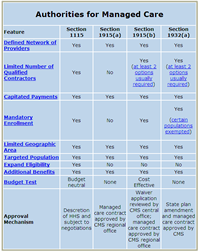Authorities that Allow Managed Care
Managed care authorities allow you to enroll beneficiaries into a managed care service delivery system, which typically includes a defined network of providers and a capitated payment system. In general, the managed care regulations at 42 CFR 438 will apply.
Key requirements in the regulations include the following:
- Beneficiaries enrolled in mandatory managed care must have a choice of at least two qualified entities, with exceptions for rural areas.
- Qualified entities may include managed care organizations (MCOs), which can have a comprehensive full-risk contract; prepaid ambulatory health plans (PAHPs), which are not responsible for inpatient services; and prepaid inpatient health plans (PIHPs), which must be responsible for at least inpatient and institutional services.
- The state must have strategies in place for performance assessment and quality improvement.
- Member rights and protections must be assured, including protection from certain marketing practices.
- Capitation rates must be actuarially sound and certified by actuaries.
Managed care authorities do not contain services. They allow existing Medicaid services to be offered in a managed care delivery system. Generally, managed care includes:
- A defined network of providers, as opposed to the freedom to choose any qualified provider under Section 1902;
- Selective contracting on the part of the Medicaid program, as opposed to giving an agreement to any qualified vendor;
- Capitated payments, in which the managed care contractor accepts a set monthly amount to provide a package of services, as opposed to being reimbursed for each service provided.
Table 5.B summarizes the features available through four different authorities.


